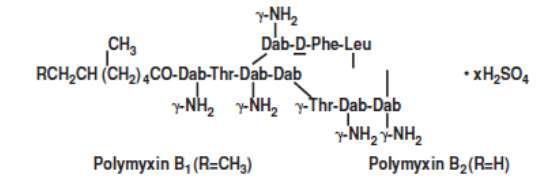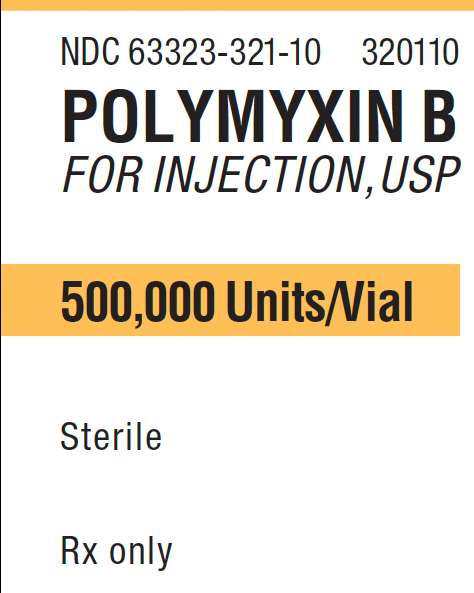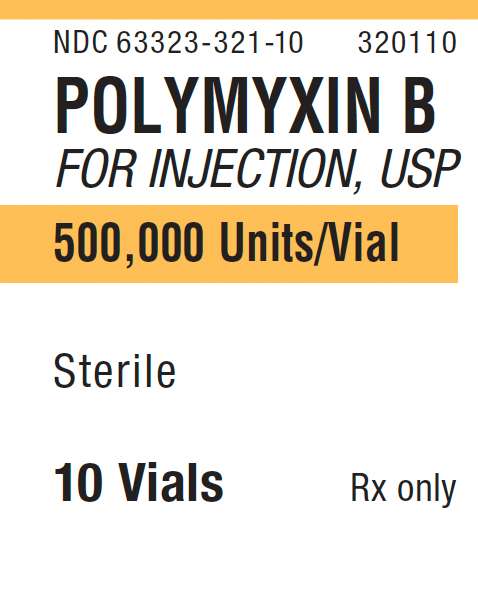Polymyxin B
Polymyxin B for Injection, USP
FULL PRESCRIBING INFORMATION: CONTENTS*
- POLYMYXIN B DESCRIPTION
- CLINICAL PHARMACOLOGY
- POLYMYXIN B INDICATIONS AND USAGE
- POLYMYXIN B CONTRAINDICATIONS
- PRECAUTIONS
- POLYMYXIN B ADVERSE REACTIONS
- POLYMYXIN B DOSAGE AND ADMINISTRATION
- HOW SUPPLIED
FULL PRESCRIBING INFORMATION
500,000 Units
Rx only
To reduce the development of drug-resistant bacteria and maintain the effectiveness of polymyxin B and other antibacterial drugs, polymyxin B should be used only to treat or prevent infections that are proven or strongly suspected to be caused by bacteria.
|
WARNING CAUTION: WHEN THIS DRUG IS GIVEN INTRAMUSCULARLY AND/OR INTRATHECALLY, IT SHOULD BE GIVEN ONLY TO HOSPITALIZED PATIENTS, SO AS TO PROVIDE CONSTANT SUPERVISION BY A PHYSICIAN. RENAL FUNCTION SHOULD BE CAREFULLY DETERMINED AND PATIENTS WITH RENAL DAMAGE AND NITROGEN RETENTION SHOULD HAVE REDUCED DOSAGE. PATIENTS WITH NEPHROTOXICITY DUE TO POLYMYXIN B SULFATE USUALLY SHOW ALBUMINURIA, CELLULAR CASTS, AND AZOTEMIA. DIMINISHING URINE OUTPUT AND A RISING BUN ARE INDICATIONS FOR DISCONTINUING THERAPY WITH THIS DRUG. NEUROTOXIC REACTIONS MAY BE MANIFESTED BY IRRITABILITY, WEAKNESS, DROWSINESS, ATAXIA, PERIORAL PARESTHESIA, NUMBNESS OF THE EXTREMITIES, AND BLURRING OF VISION. THESE ARE USUALLY ASSOCIATED WITH HIGH SERUM LEVELS FOUND IN PATIENTS WITH IMPAIRED RENAL FUNCTION AND/OR NEPHROTOXICITY. THE CONCURRENT OR SEQUENTIAL USE OF OTHER NEUROTOXIC AND/OR NEPHROTOXIC DRUGS WITH POLYMYXIN B SULFATE, PARTICULARLY BACITRACIN, STREPTOMYCIN, NEOMYCIN, KANAMYCIN, GENTAMICIN, TOBRAMYCIN, AMIKACIN, CEPHALORIDINE, PAROMOMYCIN, VIOMYCIN, AND COLISTIN SHOULD BE AVOIDED. THE NEUROTOXICITY OF POLYMYXIN B SULFATE CAN RESULT IN RESPIRATORY PARALYSIS FROM NEUROMUSCULAR BLOCKADE, ESPECIALLY WHEN THE DRUG IS GIVEN SOON AFTER ANESTHESIA AND/OR MUSCLE RELAXANTS. USAGE IN PREGNANCY: THE SAFETY OF THIS DRUG IN HUMAN PREGNANCY HAS NOT BEEN ESTABLISHED. |
POLYMYXIN B DESCRIPTION
Polymyxin B for Injection, USP is one of a group of basic polypeptide antibiotics derived from B polymyxa ( B aerosporous ). Polymyxin B sulfate is the sulfate salt of Polymyxins B1 and B2, which are produced by the growth of Bacillus polymyxa (Prazmowski) Migula (Fam. Bacillacea). It has a potency of not less than 6000 polymyxin B units per mg, calculated on the anhydrous basis. The structural formulae are:

Each vial contains 500,000 polymyxin B units for parenteral or ophthalmic administration.
Polymyxin B for Injection is in powder form suitable for preparation of sterile solutions for intramuscular, intravenous drip, intrathecal, or ophthalmic use.
In the medical literature, dosages have frequently been given in terms of equivalent weights of pure polymyxin B base. Each milligram of pure polymyxin B base is equivalent to 10,000 units of polymyxin B and each microgram of pure polymyxin B base is equivalent to 10 units of polymyxin B.
Aqueous solutions of polymyxin B sulfate may be stored up to 12 months without significant loss of potency if kept under refrigeration. In the interest of safety, solutions for parenteral use should be stored under refrigeration and any unused portion should be discarded after 72 hours. Polymyxin B sulfate should not be stored in alkaline solutions since they are less stable.
CLINICAL PHARMACOLOGY
Polymyxin B sulfate has a bactericidal action against almost all gram-negative bacilli except the Proteus group. Polymyxins increase the permeability of bacterial cell wall membranes. All gram-positive bacteria, fungi, and the gram-negative cocci, N gonorrhoeae and N meningitidis , are resistant.
Susceptibility plate testing: If the Kirby-Bauer method of disc susceptibility testing is used, a 300-unit polymyxin B disc should give a zone of over 11 mm when tested against a polymyxin B susceptible bacterial strain.
Polymyxin B sulfate is not absorbed from the normal alimentary tract. Since the drug loses 50 percent of its activity in the presence of serum, active blood levels are low. Repeated injections may give a cumulative effect. Levels tend to be higher in infants and children. The drug is excreted slowly by the kidneys. Tissue diffusion is poor and the drug does not pass the blood brain barrier into the cerebrospinal fluid. In therapeutic dosage, polymyxin B sulfate causes some nephrotoxicity with tubule damage to a slight degree.
POLYMYXIN B INDICATIONS AND USAGE
To reduce the development of drug-resistant bacteria and maintain the effectiveness of polymyxin B and other antibacterial drugs, polymyxin B should be used only to treat or prevent infections that are proven or strongly suspected to be caused by bacteria. When culture and susceptibility information are available, they should be considered in selecting or modifying antibacterial therapy. In the absence of such data, local epidemiology and susceptibility patterns may contribute to the empiric selection of therapy.
Acute Infections Caused by Susceptible Strains of Pseudomonas aeruginosa
Polymyxin B sulfate is a drug of choice in the treatment of infections of the urinary tract, meninges, and bloodstream caused by susceptible strains of P aeruginosa . It may also be used topically and subconjunctivally in the treatment of infections of the eye caused by susceptible strains of P aeruginosa .
It may be indicated in serious infections caused by susceptible strains of the following organisms, when less potentially toxic drugs are ineffective or contraindicated:
H influenzae , specifically meningeal infections.
Escherichia coli , specifically urinary tract infections.
Aerobacter aerogenes , specifically bacteremia.
Klebsiella pneumoniae , specifically bacteremia.
NOTE: IN MENINGEAL INFECTIONS, POLYMYXIN B SULFATE SHOULD BE ADMINISTERED ONLY BY THE INTRATHECAL ROUTE.
POLYMYXIN B CONTRAINDICATIONS
This drug is contraindicated in persons with a prior history of hypersensitivity reactions to polymyxins.
PRECAUTIONS
See “ WARNING ” box.
General
Prescribing polymyxin B in the absence of a proven or strongly suspected bacterial infection or a prophylactic indication is unlikely to provide benefit to the patient and increases the risk of the development of drug resistant bacteria.
Baseline renal function should be done prior to therapy, with frequent monitoring of renal function and blood levels of the drug during parenteral therapy.
Avoid concurrent use of a curariform muscle relaxant and other neurotoxic drugs (ether, tubocurarine, succinylcholine, gallamine, decamethonium and sodium citrate) which may precipitate respiratory depression. If signs of respiratory paralysis appear, respiration should be assisted as required, and the drug discontinued.
As with other antibiotics, use of this drug may result in overgrowth of nonsusceptible organisms, including fungi.
If superinfection occurs, appropriate therapy should be instituted.
Information for Patients
Patients should be counseled that antibacterial drugs including polymyxin B should only be used to treat bacterial infections. They do not treat viral infections (e.g., the common cold). When polymyxin B is prescribed to treat a bacterial infection, patients should be told that although it is common to feel better early in the course of therapy, the medication should be taken exactly as directed. Skipping doses or not completing the full course of therapy may (1) decrease the effectiveness of the immediate treatment and (2) increase the likelihood that bacteria will develop resistance and will not be treatable by polymyxin B or other antibacterial drugs in the future.
POLYMYXIN B ADVERSE REACTIONS
See “ WARNING ” box.
Nephrotoxic reactions : Albuminuria, cylinduria, azotemia, and rising blood levels without any increase in dosage.
Neurotoxic reactions : Facial flushing, dizziness progressing to ataxia, drowsiness, peripheral paresthesias (circumoral and stocking glove), apnea due to concurrent use of curariform muscle relaxants, other neurotoxic drugs or inadvertent overdosage, and signs of meningeal irritation with intrathecal administration, e.g., fever, headache, stiff neck and increased cell count and protein cerebrospinal fluid.
Other reactions occasionally reported : Drug fever, urticarial rash, pain (severe) at intramuscular injection sites, and thrombophlebitis at intravenous injection sites.
POLYMYXIN B DOSAGE AND ADMINISTRATION
Parenteral
Intravenous
Dissolve 500,000 polymyxin B units in 300 to 500 mL solutions for parenteral dextrose injection 5% for continuous drip.
Adults and children: 15,000 to 25,000 units/kg body weight/day in individuals with normal kidney function. This amount should be reduced from 15,000 units/kg downward for individuals with kidney impairment. Infusions may be given every 12 hours; however, the total daily dose must not exceed 25,000 units/kg/day.
Infants: Infants with normal kidney function may receive up to 40,000 units/kg/day without adverse effects.
Intramuscular
Not recommended routinely because of severe pain at injection sites, particularly in infants and children. Dissolve 500,000 polymyxin B units in 2 mL sterile water for injection or sodium chloride injection or procaine hydrochloride injection 1%.
Adults and children: 25,000 to 30,000 units/kg/day. This should be reduced in the presence of renal impairment. The dosage may be divided and given at either 4 or 6 hour intervals.
Infants : Infants with normal kidney function may receive up to 40,000 units/kg/day without adverse effects.
Note : Doses as high as 45,000 units/kg/day have been used in limited clinical studies in treating prematures and newborn infants for sepsis caused by P aeruginosa .
Intrathecal
A treatment of choice for P aeruginosa meningitis . Dissolve 500,000 polymyxin B units in 10 mL sodium chloride injection USP for 50,000 units per mL dosage unit.
Adults and children over 2 years of age: Dosage is 50,000 units once daily intrathecally for 3 to 4 days, then 50,000 units once every other day for at least 2 weeks after cultures of the cerebrospinal fluid are negative and sugar content has returned to normal.
Children under 2 years of age: 20,000 units once daily, intrathecally for 3 to 4 days or 25,000 units once every other day. Continue with a dose of 25,000 units once every other day for at least 2 weeks after cultures of the cerebrospinal fluid are negative and sugar content has returned to normal.
IN THE INTEREST OF SAFETY, SOLUTIONS OF PARENTERAL USE SHOULD BE STORED UNDER REFRIGERATION, AND ANY UNUSED PORTIONS SHOULD BE DISCARDED AFTER 72 HOURS.
Topical
Ophthalmic: Dissolve 500,000 polymyxin B units in 20 to 50 mL sterile water for injection or sodium chloride injection USP for a 10,000 to 25,000 units per mL concentration.
For the treatment of P aeruginosa infections of the eye, a concentration of 0.1 percent to 0.25 percent (10,000 units to 25,000 units per mL) is administered 1 to 3 drops every hour, increasing the intervals as response indicates.
Subconjunctival injection of up to 100,000 units/day may be used for the treatment of
P aeruginosa
infections of the cornea and conjunctiva.
Note: Avoid total systemic and ophthalmic instillation over 25,000 units/kg/day .
HOW SUPPLIED
Polymyxin B for Injection , USP , 500,000 polymyxin B units per vial is supplied as follows.
|
Product No. |
NDC No. |
Strength |
Vial size |
|
320110 |
63323-321-10 |
500,000 U/Vial |
Vial packaged in tens. |
Storage Recommendations
Before reconstitution: Store at 20° to 25°C (68° to 77°F)[see USP Controlled Room Temperature].
Protect from light. Retain in carton until time of use.
After reconstitution: Product must be stored under refrigeration, between 2° to 8°C (36° to 46°F) and any unused portion should be discarded after 72 hours.
Vial stoppers do not contain natural rubber latex.

451078A
Revised: March 2008
PACKAGE LABEL - PRINCIPAL DISPLAY - Polymyxin B 500,000 Units/Vial Vial Label
NDC 63323-321-10
320110
POLYMYXIN B FOR INJECTION, USP
500,000 Units/Vial
Sterile
Rx only

PACKAGE LABEL - PRINCIPAL DISPLAY - Polymyxin B 500,000 Units/Vial Tray Label
NDC 63323-321-10
320110
POLYMYXIN B FOR INJECTION, USP
500,000 Units/Vial
Sterile
10 Vials
Rx only

Polymyxin BPOLYMYXIN B SULFATE INJECTION, POWDER, LYOPHILIZED, FOR SOLUTION
| ||||||||||||||||||||||||||||||||||||||||||||||||||||||